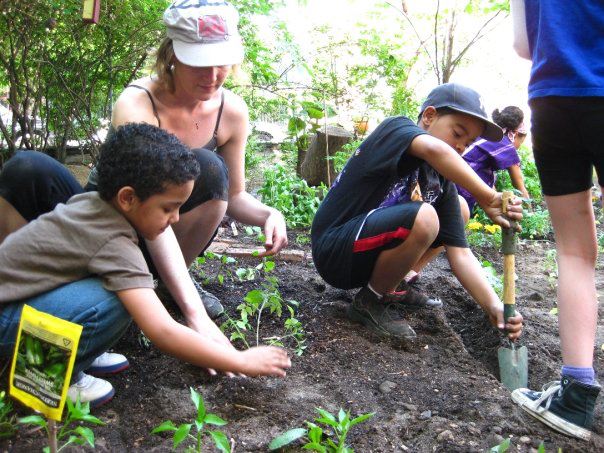Alongside the squatting movement, neighborhood activists on the LES transformed vacant lots into vibrant community gardens throughout the 70s and 80s. They fought to protect the gardens when the city tried to auction them off to developers, successfully saving 39 — giving the LES the highest concentration of community gardens in the city. Despite being officially recognized by the NYC Department of Parks and Recreation, these gardens remain 100% volunteer-run: a testament to the power of grassroots environmental organizing.
WHAT WE DO
MoRUS and Time’s Up! helped save over 400 community gardens throughout New York City through lobbying public officials; organizing and educating communities about the importance of community gardens; drawing press attention; creating visual aids (including colorful puppets and props); and encouraging non-violent direct action (including lockdown encampments and protests). The overwhelming success of these tactics has fostered similar grassroots movements for community gardens in cities across the country.
One particularly notable clash between community organizers and the city took place at Esperanza Community Garden on East 7th Street. The city had plans to raze the garden and seize the land for a new housing development. Activists occupied the garden around the clock to stop its destruction. The More Gardens Coalition, community members, and TIMES UP! environmental organization helped spur a campaign to save the garden, which attracted activists from across the country.
When the city came to demolish Esperanza Community Garden on February 15, 2000, over one hundred people gathered to defend it, with many chaining themselves to cement blocks and other objects to buy time as lawyers and activists descended upon the state courthouse to request a temporary restraining order that would prevent the impending demolition. Unwilling to wait for the judge’s order, the city went ahead and demolished the garden; most of the activists were arrested.
Infuriated by the city’s refusal to wait for his ruling, Judge Richard Hutter responded by granting a temporary restraining order which protected all remaining gardens citywide. This allowed time for a permanent deal to save most of the remaining gardens, brokered by then-New York State Attorney General Eliot Spitzer. The so-called Spitzer Agreement remains in force today.
MoRUS also helps maintain the LES’ remaining 39 gardens by arranging work days, remediating soil, clearing rubble, planting fruits, vegetables, and herbs, building and improving infrastructure such as sinks, stages, and gazebos, and composting food waste. We also hold workshops on topics such as composting, soil treatments, honeybees, and more. Within the museum, we continue to document the history of the gardens and share that knowledge with our visitors.
Now NYC community gardens are thriving, creating a safe community space and encouraging sustainable practices and education from community events workshops to urban farming. A lot of the gardens are practicing water recovery systems, composting, honey bees, medicinal plants, and organic farming, together with the network of community gardens. Not only photosynthesis keep our air clean, their leaf surfaces also absorb gaseous pollutants, such as nitrogen dioxide, sulfur dioxide, and ozone. Also, new studies have shown that green spaces, community gardens and parks are helping to prevent flooding in urban areas. The US Forest Service estimates New York City’s seven million trees remove tons of air pollutants every year.
WHY COMMUNITY GARDENS MATTER
Providing places for people to garden has been an innovative strategy to improve American urban conditions since the 1890s, when the movement began in New York and Detroit. Many kinds of community gardens came into existence at different times, often associated with times of social and economic change (as described by Laura Lawson in her book City Bountiful: A Century of Community Gardening in America).
New York’s community gardens are unique and important historical artifacts, as well as critical parts of our urban landscape. Several hundred community gardens previously existed in New York City. Many of them were created in the 1970s, when landlords abandoned their buildings, which ended up burnt out and were torn down. Because landlords failed to pay taxes on them, they reverted to the city. Community members mobilized to turn the vacant lots, filled with rubble and other debris, into vibrant gardens and parks.
Community gardens have numerous positive effects. In low-income urban areas, gardens fill a necessary gap in fresh, healthy, and affordable food. As stated in “Food for Thought: The Social Impact of Community Gardens,” published in Electronic Green Journal in 2010, gardens help to make food available, sometimes generating tons of food at a fraction of the cost of supermarket produce. New studies appreciate the benefits in social service costs as well: “by staying active in the garden and practicing better nutrition with fresh produce, gardeners reduce their heart disease, type two diabetes, and obesity, saving on medical care.” As Grace Tankersley comments in her book Community Gardens of the East Village, the gardens contribute “to the physical and psychological well being of individuals and the social cohesion of communities” as well as reduce air and water pollution and provide a lower cost alternative to formal parks.
For the nationwide community gardening movement, see the American Community Gardening Association and international guerilla gardening developments. By raising local awareness of the community gardens and their histories, MoRUS will increase the Lower East Side community’s utilization of these gardens in the short-term and help protect the gardens from developers in the long-term. The success of past activists is inspiring the creation of new community gardens today!










